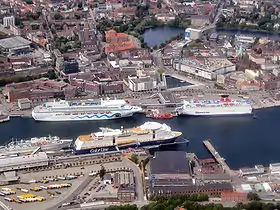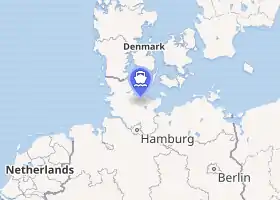Port of Kiel
The Port of Kiel (German: Kieler Hafen) is a significant port for passenger and cargo shipping located in Kiel, Germany. It occupies the inner part of the Baltic Sea inlet Kieler Förde and includes the approach to the locks at the eastern end of Kiel Canal.[2][3]
| Port of Kiel | |
|---|---|
 Ferries in the Port of Kiel | |

| |
| Location | |
| Country | |
| Location | Kiel |
| Coordinates | 54.3179°N 10.1389°E |
| UN/LOCODE | DE KEL |
| Details | |
| Operated by | Seehafen Kiel GmbH & Co. KG |
| Owned by | City of Kiel |
| Statistics | |
| Annual cargo tonnage | 7.1 million (2018)[1] |
| Passenger traffic | 2.2 million (2018)[1] |
| Website portofkiel.com | |
Harbours
The port offers sheltered harbours, large turning basins, and deep water berths.[4]
Inner Harbour
At the southern end of Kieler Förde lies the Inner Harbour (German: Stadthafen) with passenger terminals Ostseekai and Schwedenkai in the west and Norwegenkai on the eastern side. Ferries of the liner services to Scandinavia are based here and cruise ships call during summer.
Ostuferhafen
Located on the east bank of Kieler Förde, Ostuferhafen (English: East Side Harbour) is the largest coherent part of the port with a total area of 500,000 m² and a quay length of 1,700 m. It is primarily a cargo harbour with ro-ro and container terminals for the liner traffic to Northern Sweden, Russia and the Baltic states. Since June 2014 it also hosts one cruise berth.[5]
Canal Harbours
The Canal Harbours (German: Kanalhäfen) are located on the Kiel Canal. Nordhafen is situated on the southern side of the canal and has facilities for timber, bulk cargo, ro-ro, and container vessels. The bulk terminal Scheerhafen is situated immediately south of the canal locks and is formed by two moles.[6]
Passenger and cargo traffic
Kiel’s main passenger shipping business are regularly scheduled cruiseferries to Norway, Sweden, and Lithuania which served 1.6 million passengers in 2018.[1] Behind Puttgarden on Fehmarn and Rostock, Kiel is Germany's third busiest port for international passenger traffic.[7][8][9]
The two Color Line cruiseferries Color Magic and Color Fantasy offer a daily 20-hour connection from Norwegenkai to Oslo in Norway. Stena Line operates the two cruiseferries Stena Germanica and Stena Scandinavica on a daily 14.5-hour connection from Schwedenkai to Gothenburg in Sweden. DFDS Seaways runs a daily 21-hour connection from Ostuferhafen to Klaipėda in Lithuania with the two RoPax ferries Athena Seaways and Regina Seaways.[10]
The port's season for cruise ships runs from early-April through late-October, and 169 vessels called at the port in 2018. During the season, Kiel acts as home port for several vessels from the AIDA Cruises and TUI Cruises fleet. Almost 600.000 cruise passengers were handled in 2018.[1]
The Swedish paper company SCA operates two ro-ro vessels between Kiel and Sundsvall in Sweden once a week, importing paper products to Germany.
The port is owned by the city of Kiel and operated by Seehafen Kiel GmbH & Co. KG. For the year 2018, the port reported over 7.1 million tons of cargo and 2.2 million passengers (ferry and cruise) handled.[1]
References
- "Statistics". Port of Kiel. Retrieved 2020-01-06.
- "Port of Kiel restructuring". www.drycargomag.com. Retrieved 2020-01-10.
- "The Port of KIEL in Germany invests in cargo handling and environmental technology". Docks The Future. 2018-08-07. Retrieved 2020-01-10.
- "Kiel (Germany)". CruiseMapper. Retrieved 2020-01-08.
- "Our Terminals". Port of Kiel. Retrieved 2020-01-08.
- Sailing Directions (Enroute) - Baltic Sea (Southern part) (19th ed.). National Geospatial-Intelligence Agency. 2019. p. 105.
- "Fachserie. 8, Verkehr. 5, Seeschifffahrt. Monatlich" (September 2019). Statistisches Bundesamt. 2019-12-12. Cite journal requires
|journal=(help) - Ports | 14/10/19 (2019-10-14). "Port of Kiel achieves milestone with 800,000 passengers during cruise season 2019". SAFETY4SEA. Retrieved 2020-01-10.
- "Port of Kiel launches emission-free shore-based plant to power ships". Ship Technology. 2019-05-12. Retrieved 2020-01-10.
- "Cargo". Port of Kiel. Retrieved 2020-01-06.
External links
| Wikimedia Commons has media related to Kiel port. |
- Official website (in German and English)